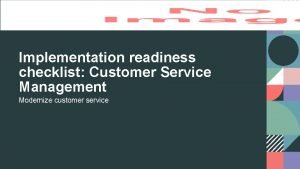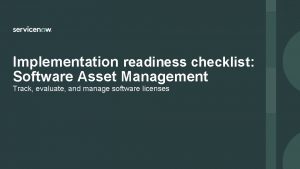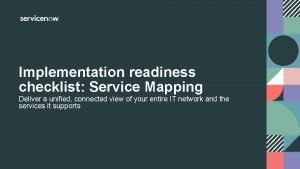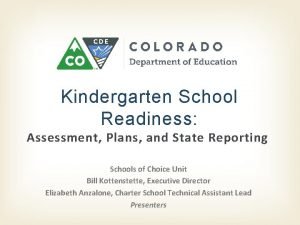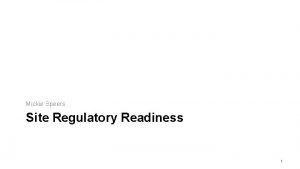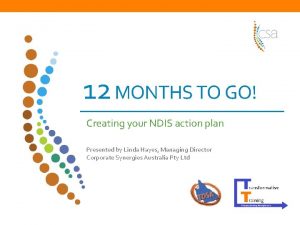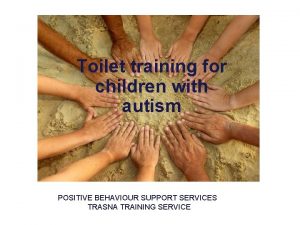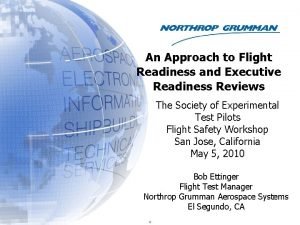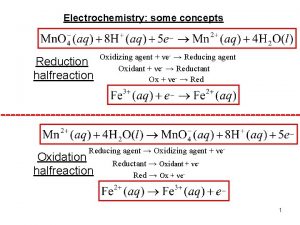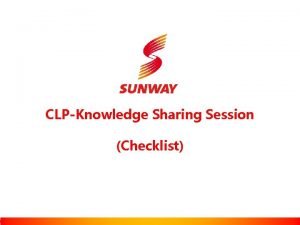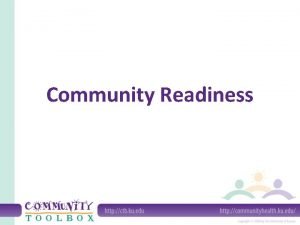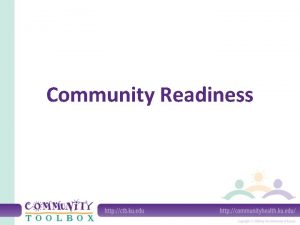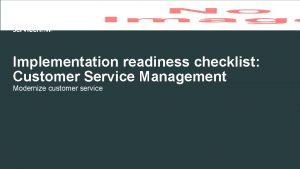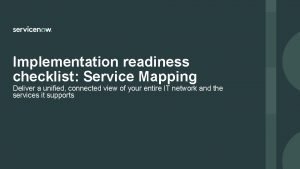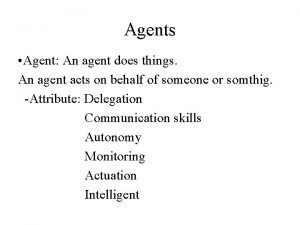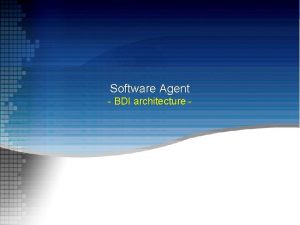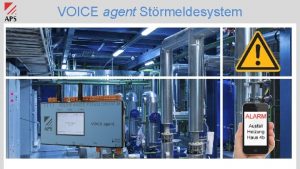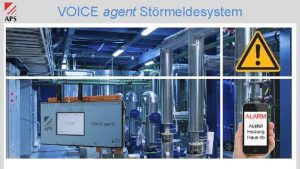Implementation readiness checklist Virtual Agent Virtual Agent implementation














- Slides: 14

Implementation readiness checklist: Virtual Agent

Virtual Agent implementation readiness checklist Introduction Service. Now® Virtual Agent makes it easy for employees and customers to get what they need whenever they need it, with an enterprise conversational experience powered by natural language understanding (NLU). Virtual Agent automatically resolves your common service requests and offers a customizable chatbot interface. Getting started with Virtual Agent is as easy as configuring out-of-the-box (OOTB) conversations for IT support, human resources and/or customer service. There are three critical success factors, in addition to the included readiness checklist activities, that are common among customers that have successfully implemented and received value from Virtual Agent: Ø Awareness of key implementation risks and pitfalls, and a plan for prevention Ø Taking the time to create an optimal design based on planned value, which helps you take advantage of new features in future releases Ø Assembling a team with the right skills (including experience with Service. Now Virtual Agent) and sponsorship from at least one executive Technology Process Virtual Agent success 2 People © 2020 Service. Now, Inc. All Rights Reserved.

Virtual Agent implementation readiness checklist Who should read this? The implementation owner, who may be a primary business stakeholder, project manager, or other stakeholder who manages the project and decisionmaking processes Intended use Use this checklist when: • You have a scoped project plan from a Service. Now expert and are using this checklist to prepare, or • You don’t have an implementation project plan yet and are using this checklist to inform your planning efforts This checklist DOES: • Help you align with the Service. Now methodology that will expedite readiness and enhance the design phase • Highlight the standard steps to prepare for implementation • Outline the design phase homework • Prepare you for some of the major decisions you’ll make during implementation design • Prepare you to understand the level of effort and complexity to go-live with your first Virtual Agent conversations This checklist DOES NOT: • Provide design, configuration, or testing activities – We recommend engaging a Service. Now certified partner or Service. Now Expert Services for planning and assistance with implementation if you don’t have this expertise internally. Note: If you’ve already completed some of the activities on this checklist—such as, defining your business objectives—document those activities before moving on to the next item in the checklist. Key readiness steps 1. Confirm the prerequisites 2. Refine your vision, objectives, and success 4. Create a structure for governance 3. Assess your team readiness 3 5. Plan for OCM activities 6. Plan for implementation design © 2020 Service. Now, Inc. All Rights Reserved.

Virtual Agent implementation readiness checklist Step 1: Confirm prerequisites Step 4: Create structure for governance See slide 5 to complete this step. See slide 8 to complete this step. �Review Virtual Agent and NLU features and functionality. �Confirm the underlying platform functionality. �Confirm the source for Service. Now implementation expertise. �Create an implementation governance committee. Step 5: Plan for OCM activities See slide 9 to complete this step. �Build an OCM plan. �Plan for a pilot rollout. Step 2: Define the vision, business objectives, and measures of success Step 6: Plan for implementation design See slide 6 to complete this step. See slides 10– 11 to complete this step. �Define your vision, business objectives, and measures �Understand your current requests and processes. of success. �Confirm existing functionality. �Document required integrations. Step 3: Assess your team readiness �Consider which OOTB conversations will be prioritized. See slide 7 to complete this step. �Identify and prepare your implementation and maintenance resources. 4 © 2020 Service. Now, Inc. All Rights Reserved.

Step 1: Confirm prerequisites Take the time to understand Virtual Agent’s and NLU’s capabilities and features and confirm that the underlying platform functionality required for your use of Virtual Agent is ready. Confirm the underlying platform functionality Practitioner insight: NLU can improve the user experience. An NLU model extracts relevant values from text received by the Virtual Agent and uses those values to provide a more natural and engaging conversational experience for the user. Review Virtual Agent and NLU features and functionality • Virtual Agent overview on the Service. Now website. Take note of the application’s features, functionality, and benefits. • Virtual Agent Community forum. Direct access to experts and peers! • Virtual Agent product docs. These resources are more technical and provide additional functionality detail. • NLU product docs. This includes information on terminology, utterances, and using the NLU model builder. • Virtual Agent Academy bi-weekly webinar • Consider your use cases for Virtual Agent (if you haven’t already determined them), such as IT support, HR, and/or customer service. You don’t have to confirm all use cases until the design phase but get an idea of how you’ll want to use Virtual Agent. The underlying platform functionality required depends on these use cases. If you’re unsure, see slide 13 containing OOTB Virtual Agent conversations and consider which would be the most useful. This will be further developed in later steps. • Confirm that you’re currently using the Now Platform® on the New York release (or later) or will be on the New York release when you begin implementation. This is required for NLU capabilities. Here are resources for upgrading, if needed. If you’re a new Service. Now customer, you must set up the core platform. • Confirm that foundational Service. Now capabilities are already deployed and in use. This is based on your use cases. For example, The most common underlying Service. Now applications used with Virtual Agent are Portal, Service Catalog, Knowledge and ITSM (if your use cases relate to HR or customer service, HRSD and/or CSM will be on this list). • The applications your Virtual Agent needs to interact with are based on your use cases. If you’re unsure which applications you need for your use of Virtual Agent, you’ll discover them during the design phase before configuration. See slides 10 -11 for design phase planning. • If you need to add applications to your current Service. Now environment, take this into account during the design phase so the application(s) you need can be designed, configured, and in production before you use Virtual Agent. 5 © 2020 Service. Now, Inc. All Rights Reserved.

Step 2: Define vision, business objectives and measures of success To gain support from leadership and stakeholders, you need a vision, business objectives, and measures of success for Virtual Agent. Make sure your implementation creates value that is measurable and take the present state into account to make sure you have an appropriate implementation plan. Suggested Virtual Agent business outcomes: Practitioner insight: If you already have an implementation project plan and you skipped Step 2, be sure you complete it before you implement. For implementation success and adoption, you need to gain sponsorship from key stakeholders and executives—and align with them on business. Make sure your project plan aligns with all outcomes from Step 2. Ø Scaling business efficiency and reducing costs while handling increased volumes of routine tasks Ø Reduced agent workload through automating routine requests Ø Improved service by providing customers and employees instant answers through 24/7 automated support Define your vision, business objectives, and measures of success • Define your vision, business objectives, and measures of success that support your overall company objectives. Include your executive sponsor in the process to alignment. Use our Success Checklist to make sure your vision cascades into clear and measurable business outcomes. Ø Faster time to resolution through reduced wait times and self-service for low complexity requests Suggested Virtual Agent success metrics: Ø Customer usage Number of: active users, new users, retained users, bot sessions, and method of choice for solving problems Ø User experience First response time, average handling time, number of transfers to live agent, time to resolution, number of completed conversations versus total conversations, chat exits prior to resolution, and survey user rating • Confirm that the vision, business goals, and measures of success are defined for impact that you can make with Virtual Agent. 6 © 2020 Service. Now, Inc. All Rights Reserved.

Step 3: Assess your team readiness There are multiple teams involved and specific skills required to implement and maintain Virtual Agent. Make sure you have the right team in place or begin with a plan to engage them. Don’t finalize your resourcing and project plans until you’ve assessed your team’s readiness. Identify and prepare your implementation and maintenance resources • Identify a project manager for implementation. This person should be experienced with leading software implementation projects, and Agile. Service. Now experience is highly preferred. • Confirm your executive sponsor is committed and fully engaged. • Confirm your business-side Service. Now platform owner is committed and fully engaged (typically a senior manager to VP). Practitioner insight: If you’re engaging external Service. Now experts for implementation, make sure your internal maintenance team is involved in the implementation design and configuration activities so they can own system maintenance without knowledge transfer once implementation is complete. • Confirm your technical team has the needed skills for implementation and maintena nce: Ø Service. Now systems administrator – Experienced in Service. Now implementation and has taken Virtual Agent training • Identify the business process owners who will provide input for the process design (service desk process owner, and/or any process owner with a team that will provide support with Virtual Agent). Ø NLU Administrator – Experienced in Service. Now implementation, has taken Virtual Agent training and understands NLU; should become well versed with the NLU product docs from Step 1 Practitioner insight: Include a process owner who knows where employees go for support (if there are multiple options) and how employees communicate. Understanding the company lingo, acronyms, and how employees request support is important for creating NLU utterances when you create NLU models. You can find more information on NLU utterances in the NLU resources from Step 1. • Identify the technical owners for the Virtual Agent implementation and post go-live support. • Ask all technical team members who will be involved in implementation and post go-live maintenance to complete Service. Now Fundamentals training prior to design. Ø Testing resources Ø Development resources (Java. Scripting skills) Ø System administrators and developers – Introduce to Now Learning and Now Creators to encourage skills development Practitioner insight: You won’t know the estimated effort or commitment of resources until the implementation scope and project plan are confirmed. See Step 4 for design phase planning and consult a Service. Now certified partner or Service. Now Expert Services if you’re unsure of what your resource plan should be. 7 © 2020 Service. Now, Inc. All Rights Reserved.

Step 4: Create structure for governance Governance for your Virtual Agent journey should include implementation governance and post-implementation governance. Implementation governance supports successful implementation, and post-implementation governance supports the long-term success of Virtual Agent in your environment. Your implementation governance team should identify your post-implementation (maintenance) governance team before disbanding. Create an implementation governance committee • This committee should include your Service. Now platform owner, business process owners (ITSM, HRSD, CSM these depend on Virtual Agent conversations and processes in scope), IT service desk lead, partner representative, project manager, and other business stakeholders as required. Your executive sponsor should chair this committee. • Define a meeting cadence, standard agenda, and decision process. In addition to standard project tracking, meetings should include: Ø Project objectives (e. g. , improvements to process performance, technical usability) clearly identified and prioritized. Ø A review of organizational change management activities. See slide 9 for OCM plan development. • Work with your executive sponsor and Service. Now platform owner to develop a responsibility assignment matrix (RACI) to establish a common, documented understanding of decision rights for the migration project. Practitioner insight: The governance structure you establish for implementation should set an initial baseline for the governance you’ll need for post go-live maintenance, especially to manage demand. See our Customer Success Center resources for additional details. • Confirm that your governance team is prepared to define measures of success for enterprise, IT, and operational objectives. These measures of success should come from the goals and metrics discovered in Step 2. 8 © 2020 Service. Now, Inc. All Rights Reserved.

Step 5: Plan for OCM activities Consider organizational change management (OCM) activities throughout planning and implementation for successful adoption and long-term success. Build an OCM plan Plan for a pilot • Confirm that you have leadership and executive sponsor support for OCM and enablement, including budget for an OCM program lead and/or Service. Now expert support. This should also include an explicit definition from leadership about what good OCM should look like for your organization. Initiate a limited scope pilot after the design phase and before the larger-scale Virtual Agent implementation. This is important for showing quick wins for effective OCM—and pilot feedback will enhance the quality of the larger scale Virtual Agent implementation. Here are our recommendations for a Virtual Agent pilot: • Conduct an OCM readiness assessment to measure how ready your stakeholders are for the organizational change needed to support Virtual Agent. This should be conducted before design discussions. • Use OCM resources to start your OCM plan. • Develop a communication strategy to ensure the best modes of communication are used. • Establish a regular meeting cadence to keep the plan on track. • Create a training plan for end users so they’re prepared to use the system at go-live. This is separate from platform training for systems administrators and implementers described in previous steps. • Start discussions with two to four small teams that would highly benefit from Virtual Agent, are interested in Virtual Agent, and can commit to a pilot. • Confirm the chosen team is willing to share feedback and the value they gained from the pilot. • Put a structure in place to document the lessons learned from the pilot. • Confirm the scope and dates for the pilot during the design phase. Most pilot scopes start small, enabling three to five Virtual Agent conversation intents. 9 © 2020 Service. Now, Inc. All Rights Reserved.

Step 6 a: Understand current requests and processes The implementation design process involves multiple teams, collaborative decision-making, and a thorough understanding of your current processes and technical environment. Due to this, it can often take weeks or longer to collect necessary information, coordinate the right people, and solidify decisions during the design phase (Prepare phase in Now Create). By following the action items in Step 6, you can proactively collect design-related information and initiate engagement with the required stakeholders. This will enhance and expediate the design process. If you’re engaging a Service. Now-certified partner or Service. Now Expert Services for creating an implementation project plan, provide the items in this section to enhance project planning conversations. If preferred, complete this section with your services partner. Understand your current requests and processes Work with business process owners to document your current service request types, processes, and related teams. This includes existing selfservice processes, if any. • Create wireframe process guides or diagrams to illustrate how all service requests are handled in the environment currently, including the portals associated with the requests. If there are many complex processes, start with the service request processes that are the most compatible with self-service solutions—but the more complete this diagram is, the better. This may require collaboration with other departments. Ø Include the persona and supporting information for who is making the request and who is handling the request. Ø Include details about the types of requests (such as password reset) and the resources (such as service desk agents) who typically resolve the requests. • Document your 10 most common service requests (that relate to your use cases from Step 1) and the 10 least complex service requests that are the most compatible with self-service. These 20 requests will be considered when choosing OOTB conversations in the design phase and may inform building future conversations. Practitioner insight: If needed, use data to find your most common service requests. Use Service. Now Performance Analytics or other reporting tools to create a list of the most common incidents and/or cases. • List any concerns or roadblocks you foresee for implementing or adopting Virtual Agent. • List details for self-service options in your current environment. Practitioner insight: If there are no current self-service options, take note that you may need additional OCM efforts for awareness and adoption when Virtual Agent is deployed. 10 © 2020 Service. Now, Inc. All Rights Reserved.

Step 6 b: Document technical environment, OOTB options Confirm existing functionality Document all Service. Now applications currently in use and any systems that may interact with Virtual Agent. Here’s a list of the most common Service. Now applications used with Virtual Agent. Confirm any that are applicable to your environment, based on your use cases. This information will be used to assist with architecture and process design. Document required integrations Service. Now provides three OOTB integrations with Virtual Agent. Confirm which, if any, will be used in your implementation. • Service Portal • Workplace by Facebook • Service Catalog • Knowledge Base Most Virtual Agent implementations use these applications. • Mobile • IT Service Management (ITSM) – If use cases are for ITSM • HR Service Delivery (HRSD) – If use cases are for HR • Customer Service Management (CSM) – If use cases are for CSM • Performance Analytics – If incident or case analytics are desired • Slack • Microsoft Teams • Any additional integrations that may be needed • Related integration diagrams and/or technical details for planning from your architecture team Consider which OOTB conversations will be prioritized See slide 13 for an outline of OOTB conversations. These Service. Now Virtual Agent conversation docs have additional information on OOTB conversations. This information is useful for design planning and estimating implementation effort. Choose OOTB conversations based on your business outcomes or goals. • List any additional Service. Now applications that may interact with Virtual Agent • Choose ITSM OOTB conversations • Any other systems that may interact with Virtual Agent • Choose HRSD OOTB conversations Practitioner insight: The Virtual Agent should be initiated from the most widely used Service Portal. If there are multiple portals in use, we recommend configuring a master portal. • Document any non-OOTB conversations to consider • Choose CSM OOTB conversations • Determine whethere will be a hand-off to a live agent 11 © 2020 Service. Now, Inc. All Rights Reserved.

Appendix

NEW YORK OOTB conversations: ITSM, HRSD, CSM EMPLOYEE EXPERIENCE PORTAL CUSTOMER SERVICE PORTAL IT Service Management HR Service Delivery 1. Check IT ticket status 2. Create change request 3. Create problem 4. Email issues 5. Email setup 6. Escalate IT ticket 7. Get password reset link 8. Guest Wi-Fi access 9. Identify available change windows 10. Identify scheduled changes 11. Local admin access 12. Manage distribution list 13. Meeting room issues 14. My assigned equipment 1. 2. 3. 4. 5. 6. 7. 8. 9. 15. Open IT ticket 16. Printer issues 17. Process approval 18. Repository access 19. Resolve incident 20. Reset RSA token 21. Search knowledge base 22. Service disruptions 23. Submit a request 24. Troubleshoot slow computer 25. Update assigned task 26. Update change request 27. VPN connectivity 28. Walk-up check-in VA common topics General HR inquiry Request for leave Pay discrepancy Update address Update email Update phone number Add emergency contact Delete emergency contact Update emergency contact Customer Service Management 1. Check case status 2. Get help with product 3. Get help with order ● Greetings ● End conversations ● What can you do ● Date and time ● Live agent ● Feedback 13 © 2020 Service. Now, Inc. All Rights Reserved.

Customer Success Best Practices Service. Now’s Best Practice Center of Excellence provides prescriptive, actionable advice to help you maximize the value of your Service. Now investment. Definitive guidance on a breadth of topics Created and vetted by experts Strategic Best practice insights from customers, partners, and Service. Now teams Critical processes Management Expert insights Distilled through a rigorous process to enhance your success Tactical Designed for: Platform owners and teams Practical Actionable Valueadded Expertvalidated Based on thousands of successful implementations across the globe Technical Common pitfalls and challenges Executive sponsors Proven to help you transform with confidence Service and process owners Get started today. Visit Customer Success Center. 14 Contact your Service. Now team for personalized assistance. © 2020 Service. Now, Inc. All Rights Reserved.
 Implementation readiness checklist
Implementation readiness checklist Checklist customer service
Checklist customer service Implementation readiness checklist
Implementation readiness checklist Service readiness checklist
Service readiness checklist Colorado kindergarten readiness assessment
Colorado kindergarten readiness assessment Regulatory readiness checklist
Regulatory readiness checklist Emdr readiness checklist
Emdr readiness checklist Career readiness checklist
Career readiness checklist Ndis readiness checklist
Ndis readiness checklist Toileting task analysis
Toileting task analysis Test readiness review checklist
Test readiness review checklist What is oxidation agent
What is oxidation agent Oil rig oxidation
Oil rig oxidation Peas for part picking robot
Peas for part picking robot Agent function vs agent program
Agent function vs agent program

